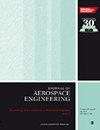Effect of a curved turning vane on the heat transfer and fluid flow of four-pass internal cooling channels of gas turbine blades
IF 1.1
4区 工程技术
Q3 ENGINEERING, AEROSPACE
Proceedings of the Institution of Mechanical Engineers Part G-Journal of Aerospace Engineering
Pub Date : 2023-10-03
DOI:10.1177/09544100231204950
引用次数: 0
Abstract
This numerical study examined the effects of a curved turning vane on the heat transfer and pressure loss of a four-pass internal cooling channel. Three-dimensional omega-based Reynolds stress (RSM-ω) turbulence model equations were used in the computation process. Three different curved turning vane configurations were studied using a simple, without a turning vane under stationary and rotating conditions for Reynolds numbers between 20,000 and 60,000 and a rotation number of 0.042. The numerical results showed good agreement with previous experimental data. Under both stationary and rotating conditions, the curved turning vane in a hub turn reduced the pressure drop significantly compared to the conventional turning vanes. Although a curved turning vane attenuated overall heat transfer, the local heat transfer increased it in particular regions, such as the hub turn and the fourth turn of cooling passages, particularly in cases with smaller radii. Coolant flow through the hub turn of the serpentine channel can reduce recirculation, separation, and flow impingement, which are unfavorable factors of pressure loss, owing to the semi-circular configuration of the curved turning vane. Regarding the rotating conditions, four-pass channels with a smaller radius of a curved turning vane provide better overall cooling performance.弯曲叶片对燃气轮机叶片四道内冷却通道传热和流体流动的影响
本文研究了弯曲叶片对四道内冷却通道传热和压力损失的影响。在计算过程中采用三维欧米伽基雷诺应力(RSM-ω)湍流模型方程。在雷诺数为20000 ~ 60000,旋转数为0.042的条件下,研究了三种不同的弯曲转叶构型。数值计算结果与前人的实验数据吻合较好。在静止和旋转两种工况下,轮毂旋转时弯曲叶片的压降都明显低于常规叶片。虽然弯曲的转向片降低了整体传热,但局部传热在特定区域增加了传热,例如轮毂转和冷却通道的第四转,特别是在半径较小的情况下。由于弯曲转叶的半圆形结构,冷却液流经蛇形通道的轮毂转动,可以减少再循环、分离和流动冲击等不利的压力损失因素。在旋转条件下,四道通道与更小的弯曲转叶半径提供更好的整体冷却性能。
本文章由计算机程序翻译,如有差异,请以英文原文为准。
求助全文
约1分钟内获得全文
求助全文
来源期刊

CiteScore
2.40
自引率
18.20%
发文量
212
审稿时长
5.7 months
期刊介绍:
The Journal of Aerospace Engineering is dedicated to the publication of high quality research in all branches of applied sciences and technology dealing with aircraft and spacecraft, and their support systems. "Our authorship is truly international and all efforts are made to ensure that each paper is presented in the best possible way and reaches a wide audience.
"The Editorial Board is composed of recognized experts representing the technical communities of fifteen countries. The Board Members work in close cooperation with the editors, reviewers, and authors to achieve a consistent standard of well written and presented papers."Professor Rodrigo Martinez-Val, Universidad Politécnica de Madrid, Spain
This journal is a member of the Committee on Publication Ethics (COPE).
 求助内容:
求助内容: 应助结果提醒方式:
应助结果提醒方式:


